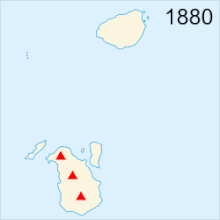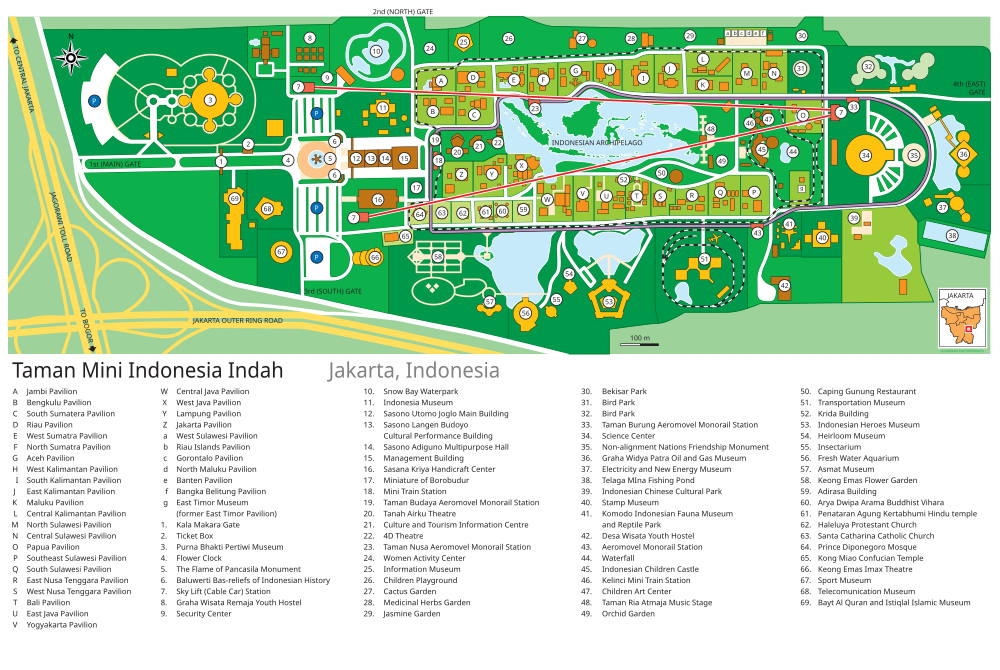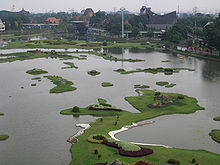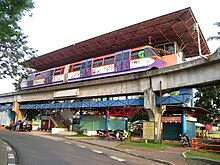Krakatoa, or Krakatau (Indonesian: Krakatau), is a volcanic island situated in the Sunda Strait between the islands of Java and Sumatra in the Indonesian province of Lampung. The name is also used for the surrounding island group comprising the remnants of a much larger island of three volcanic peaks which was obliterated in a cataclysmic 1883 eruption, unleashing huge tsunamis (killing more than 36,000 people) and destroying over two-thirds of the island. The explosion is considered to be the loudest sound ever heard in modern history, with reports of it being heard up to 3,000 miles (4,800 km) from its point of origin. The shock waves from the explosion were recorded on barographs worldwide for days afterward.
In 1927 a new island, Anak Krakatau, or "Child of Krakatoa", emerged from the caldera formed in 1883 and is the current location of eruptive activity.
Historical significance
The most notable eruptions of Krakatoa culminated in a series of massive explosions over August 26–27, 1883, which were among the most violent volcanic events in recorded history.
The 1883 eruption ejected approximately 25 km
3 (6 cubic miles) of rock.
[3] The cataclysmic explosion was heard 4,800 km (3,000 mi) away in
Alice Springs, as well as on the island of
Rodrigues near
Mauritius, 4,653 km (2,891 mi) to the west.
According to the official records of the
Dutch East Indies colony, 165 villages and towns were destroyed near Krakatoa, and 132 were seriously damaged. At least 36,417 people died, and many more thousands were injured, mostly from the
tsunamis that followed the explosion. The eruption destroyed two-thirds of the island of Krakatoa.
Eruptions in the area since 1927 have built a new island at the same location, named Anak Krakatau (which is Indonesian for "Child of Krakatoa"). Periodic eruptions have continued since, with recent eruptions in 2009, 2010, 2011, and 2012. As of late 2011, this island has a radius of roughly 2 kilometres (1.2 mi), and a high point of about 324 metres (1,063 ft) above sea level, growing 5 metres (16 ft) each year.
Etymology
Although there are earlier descriptions of an island in the Sunda Strait with a "pointed mountain," the earliest mention of Krakatoa by name in the
western world was on a 1611 map by
Lucas Janszoon Waghenaer, who labelled the island "Pulo Carcata" (
pulo is the
Sundanese word for "island"). About two dozen variants have been found, including
Crackatouw, Cracatoa, and
Krakatao (in an older Portuguese-based spelling). The first known appearance of the spelling
Krakatau was by Wouter Schouten, who passed by "the high tree-covered island of Krakatau" in October 1658.
The origin of the Indonesian name Krakatau is uncertain.
The
Smithsonian Institution's
Global Volcanism Program cites the Indonesian name,
Krakatau, as the correct name, but says that
Krakatoa is often employed.While
Krakatoa is more common in the English-speaking world, the Indonesian Krakatau tends to be favored by others, including geologists.
Geographical setting
Indonesia has over 130 active volcanoes,
[11] the most of any nation. They make up the axis of the Indonesian
island arcsystem, which was produced by northeastward subduction of the
Indo-Australian Plate. A majority of these volcanoes lie along Indonesia's two largest islands, Java and Sumatra. These two islands are separated by the Sunda Strait, which is located at a bend in the axis of the island arc. Krakatoa is directly above the
subduction zone of the
Eurasian Plate and the Indo-Australian Plate where the plate boundaries make a sharp change of direction, possibly resulting in an unusually weak crust in the region.
Pre-1883 history
At some point in
prehistory, an earlier caldera-forming eruption had occurred, leaving as remnants
Verlaten (or
Sertung);
Lang (also known as Rakata Kecil, or Panjang);
Poolsche Hoed; ("Polish Hat")
[12] and the base of
Rakata. Later, at least two more cones (
Perboewatan and
Danan) formed and eventually joined with Rakata, forming the main island of Krakatoa.
[13] At the time of the 1883 eruption, the Krakatoa group comprised Lang, Verlaten, and Krakatoa itself, an island 9 km (5.6 mi) long by 5 km (3.1 mi) wide. There were also the tree-covered islet near Lang (Poolsche Hoed) and several small rocky islets or banks between Krakatoa and Verlaten.
There were three volcanic cones on Krakatoa island: Rakata, (820 m or 2,690 ft) to the south; Danan, (450 m or 1,480 ft) near the center; and Perboewatan, (120 m or 390 ft) to the north.
416 AD event
A thundering sound was heard from the mountain Batuwara [now called
Pulosari, an extinct volcano in
Bantam, the nearest to the Sunda Strait] which was answered by a similar noise from Kapi, lying westward of the modern Bantam [(
Banten) is the westernmost province in Java, so this seems to indicate that Krakatoa is meant]. A great glowing fire, which reached the sky, came out of the last-named mountain; the whole world was greatly shaken and violent thundering, accompanied by heavy rain and storms took place, but not only did not this heavy rain extinguish the eruption of the fire of the mountain Kapi, but augmented the fire; the noise was fearful, at last the mountain Kapi with a tremendous roar burst into pieces and sank into the deepest of the earth. The water of the sea rose and inundated the land, the country to the east of the mountain Batuwara, to the mountain
Rajabasa[the most southerly volcano in Sumatra], was inundated by the sea; the inhabitants of the northern part of the Sunda country to the mountain Rajabasa were drowned and swept away with all property
[14] ... The water subsided but the land on which Kapi stood became sea, and Java and Sumatra were divided into two parts.
There is no geological evidence of a Krakatoa eruption of this size around that time; it may describe loss of land which previously joined Java to Sumatra across what is now the narrow east end of the Sunda Strait; or it may be a mistaken date, referring to a later eruption in 535 AD, for which there is some corroborating historical evidence.
[15]
535 AD event
David Keys, Ken Wohletz, and others have postulated that a violent volcanic eruption, possibly of Krakatoa, in 535 may have been responsible for the
global climate changes of 535–536.
[15] Keys explores what he believes to be the radical and far-ranging global effects of just such a putative 6th-century eruption in his book
Catastrophe: An Investigation into the Origins of the Modern World. Additionally, in recent times, it has been argued that it was this eruption which created the islands of Verlaten, Lang, and the beginnings of Rakata—all indicators of early Krakatoa's caldera's size. To date, however, little datable charcoal from that eruption has been found.
Thornton mentions that Krakatoa was known as "The Fire Mountain" during Java's
Sailendra dynasty, with records of seven eruptive events between the 9th and 16th centuries.
[16] These have been tentatively dated as having occurred in 850, 950, 1050, 1150, 1320, and 1530.
1680

Satellite view of Krakatau Islands, 18 May 1992
In February 1681,
Johann Wilhelm Vogel, a Dutch mining engineer at Salida, Sumatra (near
Padang), on his way to Batavia (modern
Jakarta) passed through the Sunda Strait. In his diary he wrote:
...I saw with amazement that the island of Krakatoa, on my first trip to Sumatra [June 1679] completely green and healthy with trees, lay completely burnt and barren in front of our eyes and that at four locations was throwing up large chunks of fire. And when I asked the ship's Captain when the aforementioned island had erupted, he told me that this had happened in May 1680 ... He showed me a piece of pumice as big as his fist.
Vogel spent several months in Batavia, returning to Sumatra in November 1681. On the same ship were several other Dutch travellers, including
Elias Hesse, a writer. Hesse's journal reports:
...on the 19th [of November 1681] we again lifted anchor and proceeded first to the north of us to the island of Sleepzie (
Sebesi), uninhabited, ... and then still north of the island of Krakatou, which erupted about a year ago and also is uninhabited. The rising smoke column of this island can be seen from miles away; we were with our ship very close to shore and we could see the trees sticking out high on the mountain, and which looked completely burned, but we could not see the fire itself.
[17]
The eruption was also reported by a Bengali sea captain, who wrote of the event later, but who had not recorded it at the time in the ship's log. Neither Vogel nor Hesse mention Krakatoa in any real detail in their other passages, and no other travelers at the time mention an eruption or evidence of one. (In November 1681, a pepper crop was being offered for sale by inhabitants.)
[19] In 1880, Verbeek investigated a fresh unweathered lava flow at the northern coast of Perboewatan, which could not have been more than two centuries old.
Visit by HMS Discovery
In February 1780 the crews of
HMS Resolution (1771) and
HMS Discovery (1774), on the way home after Captain
James Cook's death in
Hawaiʻi, stopped for a few days on Krakatoa. They found two springs on the island, one fresh water and the other hot. They described the natives who then lived on the island as "friendly" and made several sketches. (In his journal,
John Ledyard calls the island "Cocoterra.")
Visit by USS Peacock
Edmund Roberts calls the island
Crokatoa in his journal. A paraphrased account follows: On 8 September 1832,
US sloop-of war Peacock anchored off the north end, also visiting
Long Island, in search of inhabitants, fresh water, and yams. It was found difficult to effect a landing any where, owing to a heavy surf and to the coral having extended itself to a considerable distance from the shore. Hot springs boiling furiously up, through many fathoms of water, were found on the eastern side of Krakatoa, 150 feet from the shore. Roberts, Captain
Geisinger, and marine Lieutenant Fowler visited Forsaken island, having mistaken the singing of locusts for the sound of running water. The boat glided over crystal clear water, over an extensive and highly beautiful submarine garden. Corals of every shape and hue were there; some resembling sunflowers and mushrooms; others, cabbages from an inch to three feet in diameter: while a third bore a striking likeness to the rose. The hillsides were typical of tropical climate; large flocks of parrots, monkeys in great variety, wild-mango and orange groves—a superb scene of plants and flowers of every description, glowing in vivid tints of purple, red, blue, brown, and green—but not the so-much-needed supply of water and provisions.
[20]
Dutch activity
In 1620 the
Dutch set up a naval station on the islands and somewhat later a shipyard was built. Sometime in the late 17th century an attempt was made to establish a
pepper plantation on Krakatoa but the islands were generally ignored by the
Dutch East India Company. In 1809 a
penal colony was established at an unspecified location, which was in operation for about a decade. By the 1880s the islands were without permanent inhabitants; the nearest settlement was the nearby island of
Sebesi (about 12 km away) with a population of 3,000.
Several
surveys and
mariners'
charts were made, and the islands were little explored or studied. An 1854 map of the islands was used in an English chart, which shows some difference from a Dutch chart made in 1874. In July 1880,
Rogier Verbeek, made an official survey of the islands but he was only allowed to spend a few hours there. He was able to collect samples from several places, and his investigation proved important in judging the geological impact of the 1883 eruption
1883 eruption

Two-thirds of the original Krakatoa Island was obliterated by the 1883 eruption

Evolution of the islands around Krakatoa from 1880 to 2005. Note the continuing growth of Anak Krakatoa after the 1883 event.
While seismic activity around the volcano was intense in the years preceding the cataclysmic 1883 eruption, a series of lesser eruptions began on May 20, 1883. The volcano released huge plumes of steam and ash lasting until late August.
On August 27 a series of four huge explosions almost entirely destroyed the island. The explosions were so violent that they were heard 3,110 km (1,930 mi) away in
Perth,
Western Australia, and the island of
Rodrigues near
Mauritius, 4,800 km (3,000 mi) away.
[4] The pressure wave from the final explosion was recorded on barographs around the world. Several barographs recorded the wave seven times over the course of five days: four times with the wave travelling away from the volcano to its
antipodal point, and three times travelling back to the volcano.
[21]:63Hence, the wave rounded the globe three and a half times. Ash was propelled to a height of 80 km (50 mi). The sound of the eruption was so loud it was reported that if anyone was within ten miles (16 km), they would have gone deaf.
The combined effects of
pyroclastic flows, volcanic ashes, and
tsunamis had disastrous results in the region and world-wide. The death toll recorded by the Dutch authorities was 36,417, although some sources put the estimate at more than 120,000. There are numerous documented reports of groups of human skeletons floating across the Indian Ocean on rafts of volcanic pumice and washing up on the east coast of Africa up to a year after the eruption. Average global temperatures fell by as much as 1.2 degrees Celsius in the year following the eruption. Weather patterns continued to be chaotic for years and temperatures did not return to normal until 1888.
Subsequent volcanism
Anak Krakatau
Verbeek, in his report on the eruption, predicted that any new activity would manifest itself in the region which had been between Perboewatan and Danan. This prediction came true on 29 December 1927, when a submarine
lava dome in the area of Perboewatan showed evidence of eruptions (an earlier event in the same area had been reported in June 1927). A new island volcano rose above the waterline a few days later. The eruptions were initially of pumice and ash, and that island and the two islands that followed were quickly eroded away by the sea. Eventually a fourth island named Anak Krakatau broke water in August 1930 and produced lava flows faster than the waves could erode them. These new islands are of considerable interest to
volcanologists, and have been the subject of extensive study.
Volcanic activity at Anak Krakatau, 2008
2010: The thick brown plume of ash, steam and volcanic gas rising from Anak Krakatau in this true-colour satellite image is a common sight at the volcano
-
Current activity

An eruption in summer 1999
Anak Krakatau has grown at an average rate of five inches (13 cm) per week since the 1950s. This equates to an average growth of 6.8 meters per year. The island is still active, with its most recent eruptive episode having begun in 1994. Quiet periods of a few days have alternated with almost continuous
Strombolian eruptions since then.
Hot gases, rocks, and lava were released in an eruption in April 2008. Scientists monitoring the volcano have warned people to stay out of a 3 km zone around the island.
[23] Several videos of Krakatoa on
YouTube show recent footage of eruptions
[24] and of the inside of the crater as seen from the rim of the volcano.
[25]
On 6 May 2009 the
Volcanological Survey of Indonesia raised the eruption alert status of Anak Krakatau to Level III.
[26] A recent expedition to the volcano has revealed that a 100-meter (328-foot)-wide
lava dome is growing in its crater. The dome has two active vents that eject
incandescent gas.
Biological research
The islands had been little studied or biologically surveyed before the 1883 catastrophe—only two pre-1883 biological collections are known: one of plant specimens and the other part of a shell collection. From descriptions and drawings made by the
HMS Discovery, the
flora appears to have been representative of a typical Javan tropical
climax forest. The pre-1883
fauna is virtually unknown but was probably typical of the smaller islands in the area.
Botanical studies
From a biological perspective, the
Krakatau problem[28] refers to the question of whether the islands were completely sterilized by the 1883 eruption or whether some indigenous life survived. When the first researchers reached the islands in May 1884, the only living thing they found was a spider in a crevice on the south side of Rakata. Life quickly recolonized the islands, however; Verbeek's visit in October 1884 found grass shoots already growing. The eastern side of the island has been extensively vegetated by trees and shrubs, presumably brought there as seeds washed up by ocean currents or carried in birds' droppings (or brought by natives and scientific investigators). It is, however, in a somewhat fragile position, and the vegetated area has been badly damaged by recent eruptions.
Handl's occupancy
A German, Johann Handl, obtained a permit to mine
pumice in October 1916.
[16] His lease of 8.7 square kilometres (3.4 sq mi) (basically the eastern half of the island), was to be for 30 years. He occupied the south slope of Rakata from 1915 to 1917, when he left due to "violation of the terms of the lease." (According to Winchester, Handl arrived in 1917 and stayed there for four years.) Handl built a house and planted a garden with "4 European families and about 30
coolies". It is his party that is believed to have inadvertently introduced the
black rat to the island. Handl found unburned wood below the 1883 ash deposits while digging, and fresh water was found below 18 feet (5.5 m).
Popular culture
A large part of the 1947 children's novel
The Twenty-One Balloons by
William Pene du Bois takes place on Krakatoa, where several families have established a wealthy and fanciful colony based on fictional diamond mines on the island.
Krakatoa has been featured as a subject and a part of the story in various television and film dramas. In the 1953 film
Fair Wind to Java, an American sea captain and a pirate leader race one another to recover a fortune in
diamonds hidden on Krakatoa, which begins its final eruption as they search the island for the treasure.
[29] The island was a prominent part of the plot of '"Crack of Doom," an episode of the
Irwin Allen television series
The Time Tunnel in 1966. It was also featured as the main part of the story line in the 1969 film,
Krakatoa, East of Java (retitled
Volcano in a re-release in the 1970s), which depicts an effort to salvage a priceless cargo of
pearls located perilously close to the erupting volcano. An Indonesian martial arts action film,
Krakatau (1977), starring
Dicky Zulkarnaen and
Advent Bangun, also set the story on the mountain. In more recent years, it has been the subject of a 2006 television drama,
Krakatoa: Volcano of Destruction and again in 2008 as
Krakatoa.
In Klaus Teuber's board game
Seafarers of Catan, the "Krakatoa Variant" is a scenario involving an island composed of three volcano tiles.































